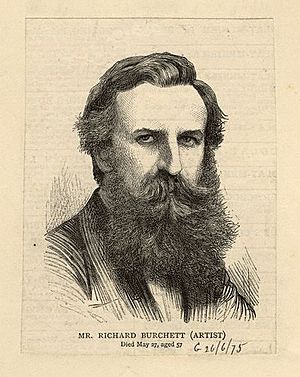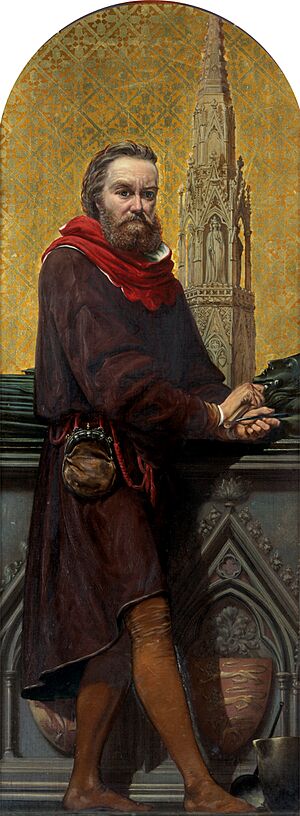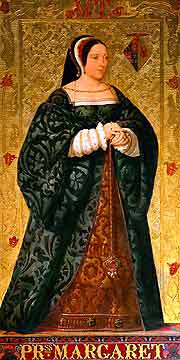Richard Burchett facts for kids
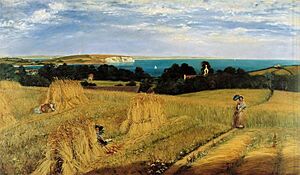

Richard Burchett (1815–1875) was a British artist and teacher. He was connected to the Pre-Raphaelite art movement. For more than 20 years, he was the Headmaster of what is now known as the Royal College of Art.
One of his former students, the poet Austin Dobson, described Burchett as "a well-taught painter, and a teacher who knew his craft very well." Many talented artists were taught by Burchett. These included Kate Greenaway, Christopher Dresser, Elizabeth Thompson (Lady Butler), Sir George Clausen, Sir Luke Fildes, Gertrude Jekyll, Hubert von Herkomer, Evelyn De Morgan, William Harbutt and Helen Allingham. Even Princess Louise, Duchess of Argyll, who was Queen Victoria's daughter and a skilled artist, was one of his students.
As an artist, Burchett was known for his large history paintings. He also decorated public buildings like parts of the Palace of Westminster and the Victoria and Albert Museum. However, modern art experts believe his best work is his View across Sandown Bay, Isle of Wight. Burchett also published his lectures as textbooks for the art education system he helped create, known as the South Kensington system.
Contents
Life of Richard Burchett
Richard Burchett was born in Brighton on January 30, 1815. He went to the "London Mechanics Institute" in Chancery Lane. This school later became Birkbeck College, part of the University of London. Around 1841, he joined the "Government School of Design." This was the same school he would later lead, and which eventually became the Royal College of Art.
In 1845, Burchett was a leader among students who protested to the Board of Trade about the teaching methods. This caused a lot of public discussion and led to a government committee looking into the matter. By 1846-47, he had become a master at the school. He stayed on staff until his death in 1875, becoming Headmaster in 1852.
Burchett spent most of his adult life working at the school. His most admired painting today is a landscape, which was unusual for him. This shows how much his own painting took a backseat to his teaching and public art projects through the school. William Bell Scott, who worked with him, said Burchett was "an able... person... whose actions rarely helped himself, but greatly helped those under him."
In the mid-1850s, Burchett became a Catholic. It is thought that he was influenced by the Pre-Raphaelite artist James Collinson, who was already Catholic. Burchett lived with Collinson for a time. Burchett was married twice and had several children. His son, Ebenezer Stanley Burchett (1837–1916), also worked at South Kensington and later became Head Master of the Bedford Park School of Arts & Crafts.
Richard Burchett was very unwell during the last years of his life. He died in Dublin on May 27, 1875. He was staying with his wife's uncle, Sir Samuel Ferguson, for his health.
Richard Burchett as an Artist
Burchett showed five of his works at the Royal Academy between 1847 and 1873. These were mostly large history paintings. One was The Death of Marmion, which was "famous in its day." The DNB describes these works as being "in the Pre-Raphaelite style." He also showed a painting at the British Institution in 1855.
His most famous work in this style is Sanctuary (1867). Its full title is Edward IV Withheld by Ecclesiastics from Pursuing Lancastrian Fugitives into a Church. This painting is in the Guildhall Art Gallery in London. It shows an event after the Battle of Tewkesbury in 1471, during the Wars of the Roses.
William Bell Scott shared a story about Burchett trying to sell Sanctuary. Burchett had chosen the subject to show the power of the Church. But a potential buyer, who was a shipping magnate, said: "I admire the picture... these men in full armour won't go in... because of that old priest... Superstition, you see, turns them into cowards!" This upset Burchett so much that he didn't sell the painting. Scott noted that Burchett "gave himself up to historical painting on a rather large scale."
However, the painting that gets the most attention from art experts today is his View across Sandown Bay, Isle of Wight. This was probably painted in 1855 and is in the Victoria and Albert Museum. They call it a "minor masterpiece." This small painting is closer to the Pre-Raphaelite landscape style. It shows a field where corn has been partly harvested. Farm tools and jugs are piled next to a stack of corn. But the only people visible are two middle-class women. One is sitting and reading, and the other is walking with a parasol. This shows that the cornfield is part of a landscape where people relax. The painting also hints at religious feeling, with a church in the distance suggesting the source of the harvest.
Burchett also created public paintings with the help of his students. These were commissioned through the school. He and his students painted full-length portraits of the House of Tudor for the House of Lords in the Palace of Westminster (1855-59). He also painted other works for the new Palace, including a large Spanish Armada scene.
He also designed mosaics for the outside of the Victoria and Albert Museum. Two of his designs, William Torrell and William of Wykeham, are still there. He and his students also decorated large medallions in the dome of the Great Exhibition building of 1862. He also painted a window in the Greenwich Hospital.
The South Kensington System of Art Education
The protests at the school in 1845 were about the Headmaster and his teaching. But they also showed bigger questions about the school's goals. People debated whether the school should focus on fine art or on art for design and business. These debates continued for many years. The new teaching methods that Burchett put in place also became a topic of discussion.
The school started in 1837 as the Government School of Design. It was located in Somerset House on the Strand. It later became the National Art Training School in 1853. It moved to Marlborough House, thanks to Prince Albert. A separate "Female School" was also set up for women students. In 1861, the main school moved again to buildings next to the Victoria and Albert Museum in South Kensington. Long after Burchett's death, it became The Royal College of Art in 1896.
The main art school in London at the time was the Royal Academy Schools. The Government School was funded by the Board of Trade. Its goal was to train designers because British industrial design was falling behind other countries. Later, a national network of schools was created to teach applied art and design. The London school was meant to be the best of these schools and to train teachers for the others.
William Dyce was the first Director of the school. Burchett studied under him and then worked with him. After internal disagreements in the 1840s, the school gained clear direction in 1853. The government put it under the control of Henry Cole. Cole was a very energetic person. He made the young painter Richard Redgrave responsible for the national art education system. He also appointed Burchett as Headmaster of the London School.
Redgrave, using Dyce's ideas and Cole's drive, created the "South Kensington system." This was a very specific plan for teaching art. It became very important in the UK and other English-speaking countries until the end of the 1800s. Burchett was the first to use this system in London. He also worked with Redgrave to create it. Burchett's published lectures explained this system and were used as textbooks.
The full course had 23 stages. Different types of students took different parts of the course. For example, "machinists, engineers and foremen" would take stages 1–5 and then the final stage. Designers took most of the stages.
There were different types of students. "General students" paid no fees and received a small living allowance. They trained to be art teachers. "National Scholars" were meant to be industrial designers. There were also students who paid fees, and their course focused more on fine arts. Women students were taught separately. Their life classes involved drawing a man wearing a suit of armor. The Royal Academy Schools did not accept women students until 1861. The female school became a popular place for young ladies.
Author and Collector
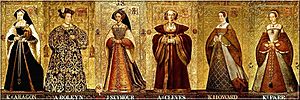
Collections of Burchett's lectures from the school were published as books. These included Practical Geometry (1855), Practical Perspective (1857), which was even translated into Chinese, and Linear Perspective for the Use of Schools of Art (1872).
Burchett also bought many items for the school at a large sale in 1855. He also bought a few things for himself. He also bought two paintings now in the Victoria and Albert Museum from the studio sale of Augustus Egg. He also sold works from his own collection to the museum, including his Sandown landscape in 1861.
Burchett took care of several paintings by his colleague, the Pre-Raphaelite artist Walter Howell Deverell (1827–54). He looked after them for ten years after Deverell's early death. He then gave them to Dante Gabriel Rossetti. These paintings included Twelfth Night, which was Deverell's most important work. Burchett likely knew Deverell since Deverell's father was the school's Secretary.
Besides his own students, Burchett also encouraged other young artists. He sent a letter of recommendation to the Royal Academy schools for the young artist Albert Moore.
Portraits of Richard Burchett
There are several portraits of Richard Burchett, who had a long beard. One is a marble bust by his student Henrietta Montalba. It is in an elaborate pink alabaster frame designed by George Clausen. This bust is now in the Royal College of Art's Darwin Building.
He was also painted by Val Prinsep. This painting shows Burchett standing next to Lord Leighton in Prinsep's Distribution of Art Prizes (1869, Victoria and Albert Museum). There is also a wood engraving of him, likely by a student, which was published with his obituary. His imagined "portrait" of the medieval metalworker William Torrell for the Victoria & Albert Museum mosaics looks quite similar to his other portraits. It might even be a self-portrait.


